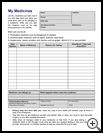
Anabolic Steroids: Teen Version
________________________________________________________________________
KEY POINTS
- Anabolic steroids are synthetic drugs that are similar to the male hormone testosterone.
- Steroids are legal in the US only if you have a healthcare provider’s prescription. Steroids that are purchased without a provider's prescription are not legal and may not be safe.
- Make sure you know how and when to take your medicine. Do not take more or less than you are supposed to take.
- Ask your healthcare provider or pharmacist what side effects the medicine may cause and what you should do if you have side effects.
________________________________________________________________________
What are anabolic steroids used for?
Anabolic androgenic steroids (AAS) are synthetic drugs that are similar to the male hormone testosterone. Most steroids are injected. Some steroids may be taken by mouth.
Healthcare providers sometimes prescribe anabolic steroids to:
- Treat men who cannot make enough testosterone naturally
- Increase weight gain in people with certain medical problems such as AIDS
Some athletes use AAS to build muscle and improve performance. However, AAS can have many serious side effects.
How do they work?
Anabolic steroids increase the body's ability to make proteins and build them into muscle tissue. Combined with a high protein food and drinks, AAS will increase muscle mass and body weight.
What else do I need to know about this medicine?
- Steroids are legal in the US only if you have a healthcare provider’s prescription. Steroids that are purchased without a provider's prescription are illegal and may not be safe. They may contain poisonous substances such as arsenic.
- AAS are not legal in organized sports. Many professional sports ban steroids and regularly test athletes for them. Athletes who test positive for steroids will be suspended or disqualified.
- Follow the directions that come with your medicine including information about food or alcohol. Ask for written information to take home. Tell your healthcare provider or pharmacist if you need information in a different language or larger type.
- Make sure you know why you are taking the medicine as well as how and when to take it. Do not take more or less than you are supposed to take.
- Try to get all of your prescriptions filled at the same place. Your pharmacist can help make sure that all of your medicines are safe to take together.
- Keep a list of your medicines with you. Tell your healthcare provider and pharmacist about all the prescription and nonprescription medicines, natural remedies, vitamins, and supplements you take.
- Many medicines have side effects. A side effect is a symptom or problem that is caused by the medicine. Ask your healthcare provider or pharmacist what side effects the medicine may cause and what you should do if you have side effects.
- Common side effects in males include:
- Severe acne
- Hair loss
- Enlarged breasts
- Decreasing testicle size
- Mood changes
- High blood pressure
- Liver, kidney, or heart problems
- Common side effects in females include:
- Acne
- Menstrual problems
- Excess facial or body hair
- Mood changes
- High blood pressure
- Liver, kidney, or heart problems
- Common side effects in males include:
If you have any questions, ask your healthcare provider or pharmacist for more information. Be sure to keep all appointments for provider visits or tests.
Last modified: 2021-12-07
Last reviewed: 2019-05-20

